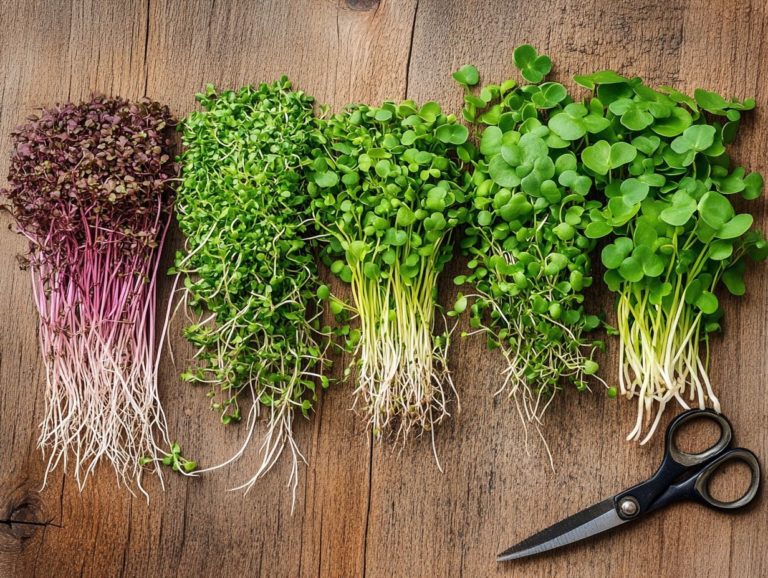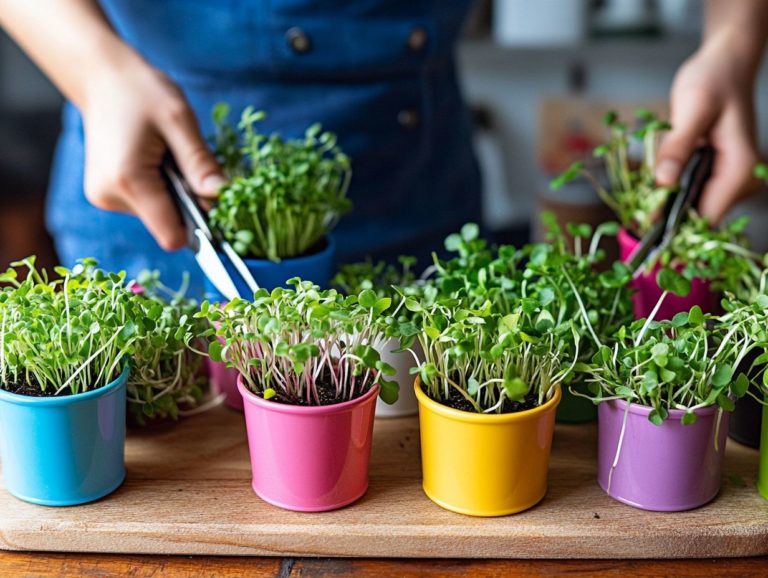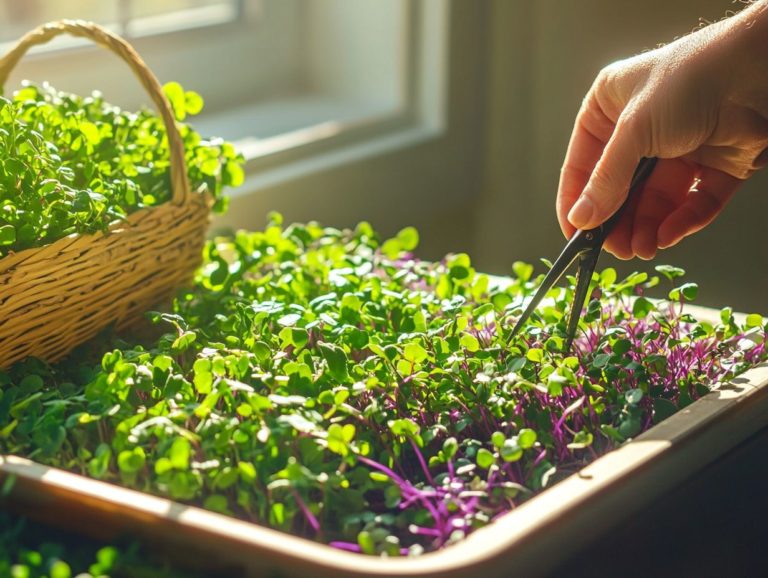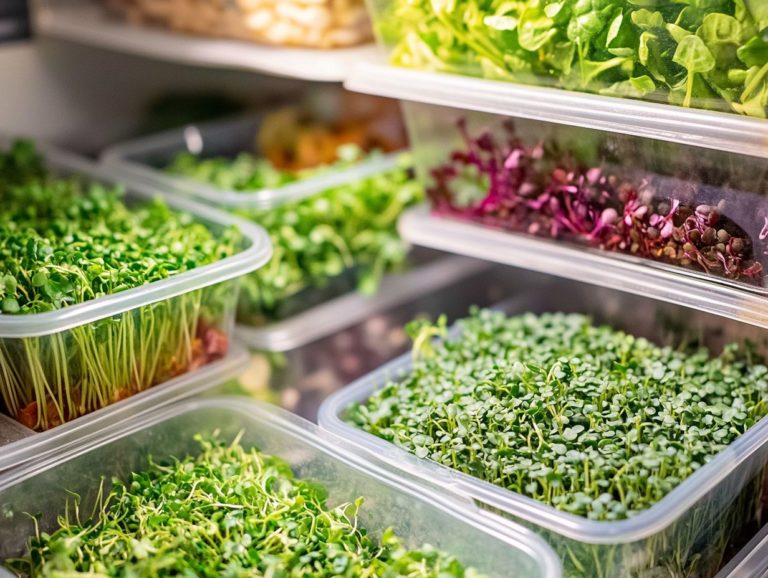The Role of Light in Microgreen Growth and Harvest
Microgreens are tiny edible plants that have become a favorite in kitchens everywhere. Packed with vibrant flavors and impressive health benefits, they are a must-try for chefs and home cooks alike.
To grow the best microgreens, you need proper lighting. This is a key factor in their development and flavor.
This article will explore the essentials of microgreens, focusing on how light affects their growth. You ll learn effective lighting techniques and get harvesting tips to boost flavor and nutrition.
Join us now as we dive into the amazing world of microgreens!
Contents
- Key Takeaways:
- The Basics of Microgreens
- The Importance of Light in Microgreen Growth
- Choosing the Right Light Source
- Lighting Techniques for Microgreens
- Harvesting Microgreens
- Frequently Asked Questions
- What is the role of light in microgreen growth and harvest?
- How does light affect the growth of microgreens?
- What are the best light conditions for microgreen growth?
- Can microgreens be grown in low light conditions?
- How does light affect the flavor of microgreens?
- Is it necessary to adjust the light exposure for different types of microgreens?
Key Takeaways:

- Light is crucial for microgreens, impacting their growth and nutrients.
- Use the right light sources to improve quality and flavor.
- Harvest at the right time to keep their nutrition intact and enhance flavor.
The Basics of Microgreens
Microgreens are young plants harvested right after their first true leaves appear. They have a rich nutrient profile and vibrant colors that add flair to any dish.
Varieties like kale, radish, and beet are packed with vitamins and antioxidants that are great for your health.
Easy to grow, microgreens are perfect for urban gardening or indoor farming, especially in small spaces. Their compact size meets the needs of health-conscious consumers seeking sustainable lighting.
What are Microgreens?
Microgreens are delightful little plants you encounter shortly after germination. They are celebrated for their bold flavors and striking colors, often enhanced by optimal light exposure.
You typically harvest these tiny greens when they are about one to three inches tall, impressively sooner than fully grown vegetables that take weeks, if not months, to mature. During their brief yet vigorous growth period, microgreens engage in rapid green pigment production, the substance that gives plants their green color and helps them grow, and the way plants make their food using sunlight. For more details on this process, check out understanding the timing of microgreen harvest. This results in impressive nutrient density and vibrant appearance, influenced by light intensity.
Unlike their mature counterparts, which can often be tougher, microgreens boast a tender and delicate texture. This makes them ideal for garnishing dishes or adding a fresh touch to salads. The best time for harvesting microgreens is when they ve developed their first true leaves, usually between 7 to 21 days post-planting, ensuring you capture their maximum flavor and nutrition.
Why are They Popular?
The rise in popularity of microgreens can easily be traced to their remarkable culinary versatility, striking visual appeal, and an array of health benefits that can’t be ignored, including high antioxidant content.
As you become more health-conscious, it s no wonder you re drawn to these tiny greens. They boast nutrient density that often outshines their mature counterparts. These compact powerhouses deliver an impressive dose of vitamins and minerals while elevating the flavor profiles of a wide range of dishes, from crisp salads to gourmet entrees.
The current surge in urban gardening trends reflects your growing desire for sustainable food practices, making microgreens an ideal choice for your kitchen. They re incredibly easy to cultivate in small spaces, allowing you to embrace self-sufficiency and environmental awareness as a city dweller eager to make a positive impact on both your diet and the planet through sustainable lighting.
The Importance of Light in Microgreen Growth
Proper lighting is essential for successfully cultivating microgreens. It profoundly influences their growth, nutrient content, and overall quality. Adequate light exposure stimulates photosynthesis, which is key for chlorophyll production and enhances plant metabolism.
Using the right type of light, especially through energy-efficient LED grow lights, can create optimal growth conditions. This leads to robust and flavorful microgreens, even in urban environments where natural sunlight may be scarce. For more insights, check out understanding light needs for microgreens.
How Light Affects Plant Growth
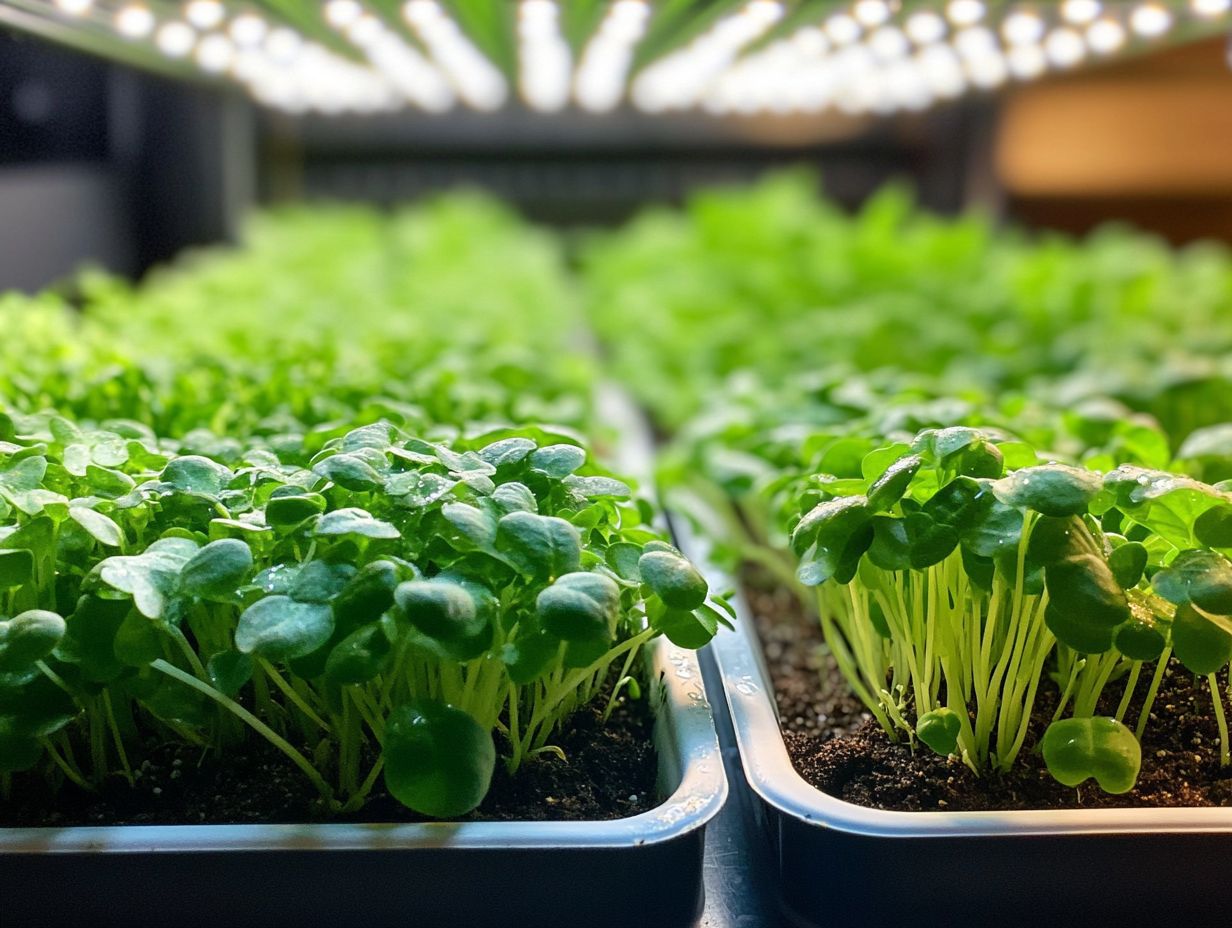
Light intensity is a game-changer for your microgreens! It significantly affects chlorophyll production and nutrient composition, which in turn impacts their health benefits.
In the early stages of growth, providing sufficient light is vital for establishing a strong root system, essential for nutrient absorption. As your seedlings develop, adjusting light conditions becomes increasingly important. Higher intensities can accelerate growth and enhance coloration, yielding healthier plants.
However, insufficient light can stifle development and reduce essential vitamins and minerals, ultimately impacting the quality of your harvest.
By fine-tuning light settings at each growth stage, you can ensure your microgreens achieve their peak nutritional value. This attention to detail results in vibrant, nutrient-rich products that health-conscious consumers crave.
Optimal Light Conditions for Microgreens
For optimal growth, microgreens require specific light conditions, including the right light duration and intensity tailored to their unique needs.
Different seed varieties have varying preferences when it comes to light levels. For example, leafy microgreens like kale thrive on approximately 12 to 16 hours of light each day. Others, such as radish or mustard greens, may do just fine with slightly less. For optimal results, it’s important to understand microgreen harvest timing as well.
Using LED grow lights is particularly effective, as they deliver the right spectrum while being energy-efficient. When managing light for these delicate plants, remember the importance of height adjustments and maintaining a consistent distance from the light source.
Employing timers can ensure your light cycles mimic natural conditions, promoting overall health and optimizing yield through strategic light management techniques.
Choosing the Right Light Source
Selecting the right light source is crucial for your microgreen cultivation. It fundamentally influences growth conditions and the overall health of your plants. While natural light has advantages, many growers lean towards artificial light sources, particularly energy-efficient LED lights.
These lights offer precise spectrum optimization, leading to enhanced growth. The ability to control light exposure and intensity with artificial sources allows you to cultivate year-round, regardless of your environment. This makes them a perfect fit for urban gardening and indoor farming.
Natural vs. Artificial Light
Natural light provides a full spectrum that is beneficial for plant growth. However, it can often be inconsistent and subject to environmental factors that affect plant growth.
For those cultivating microgreens, relying solely on sunlight can lead to many challenges, especially in areas where daylight is scarce or during seasons when the sun’s intensity diminishes. This inconsistency can significantly affect the photosynthesis process, which is essential for the vibrant growth of these delicate plants. To better understand how to optimize growth, it’s helpful to explore Understanding Microgreen Growth Cycles.
On the other hand, artificial light offers a controlled solution. It ensures your microgreens receive the necessary illumination, regardless of external conditions. Utilizing LEDs or other artificial light sources not only supplements natural light but can also serve as a dependable replacement, providing specific wavelengths that effectively promote photosynthesis. Additionally, understanding the role of temperature in microgreen growth is crucial for optimizing their development.
While the cost of electricity and the initial investment in lighting systems may present hurdles, the benefits of consistent and tailored light could well outweigh these challenges in terms of yield optimization.
Ready to optimize your light for success? Start experimenting with different light conditions for your microgreens today!
Types of Artificial Light
When it comes to artificial lighting for your microgreens, LED and fluorescent lights are the top choices. Each type has its advantages in how much power the lights use and light setup.
LEDs truly shine with their excellent energy efficiency. They use significantly less power than fluorescent lights while offering a customizable spectrum of light. This adaptability lets you choose specific wavelengths that enhance photosynthesis, which is the process plants use to turn light into food, resulting in stronger, healthier microgreens.
Fluorescent lights can be sufficient for initial growth, but they tend to produce higher heat levels and may lose efficiency over time. Understanding how these light types impact your growing conditions is essential.
For instance, LEDs can maintain a stable temperature, reducing the risk of overheating your plants. In contrast, fluorescent lights may compromise overall plant quality due to less effective light absorption.
Lighting Techniques for Microgreens

Use effective lighting techniques to boost your microgreens growth! It’s all about finding the right balance between direct and indirect light exposure to create an optimal environment for them to thrive.
Direct vs. Indirect Light
Direct light delivers a powerful punch of illumination, often speeding up growth rates. Indirect light, however, takes a subtler approach that can enhance flavor profiles.
Choosing between direct and indirect light can greatly influence microgreens’ development. Direct light typically leads to faster maturation, showcasing vibrant colors and sturdy structures. To understand the underlying factors, exploring the science behind microgreen growth is beneficial. However, this intensity can cause quicker nutrient depletion, affecting taste.
On the flip side, microgreens grown in indirect light may take longer to flourish, but they often develop richer flavors and better health benefits. This slower growth allows for a more balanced distribution of energy throughout the plant.
By understanding these dynamics, you can fine-tune your lighting strategies to achieve your desired outcomes, whether you want vibrant greens or rich-tasting varieties.
Light Cycles and Intensity
Establishing the right light cycles and intensity is vital for optimizing growth conditions in microgreens, as it directly impacts their overall health and yield.
Microgreens thrive under specific light durations and intensities. Most varieties flourish with 12 to 16 hours of light each day, leading to robust foliage and vibrant colors.
By adjusting your light settings according to their growth stages, you can unlock their full potential. Seedlings might benefit from lower intensity to prevent scorching, while mature plants often thrive under more intense light.
Customizing the light conditions for specific varieties, such as basil or radish, ensures that each type gets the ideal environment for healthy development and maximum yield.
Harvesting Microgreens
Harvest your microgreens at the right moment to enhance flavor and ensure optimal freshness.
Timing and Techniques for Harvesting
The timing of harvesting microgreens is crucial for their fresh weight and health benefits. Keep a close eye on their growth!
Understanding the best time to cut varies with each variety. For instance, radish and mustard greens may be ready for harvest in just 7 to 14 days after sowing, while others like basil or coriander typically take longer around 14 to 21 days.
When the first true leaves appear and the plants reach a height of 2 to 3 inches, that s often the perfect time to start harvesting.
Using a sharp, clean knife or scissors is essential for a clean cut, minimizing damage to the remaining plants and preserving their freshness.
Once you ve made the cut, handle the greens with care. Storing them in a cool, dark place enhances their vibrant color and nutritional profile, allowing them to retain their health benefits to the fullest.
Effects of Light on Nutrient Content and Flavor
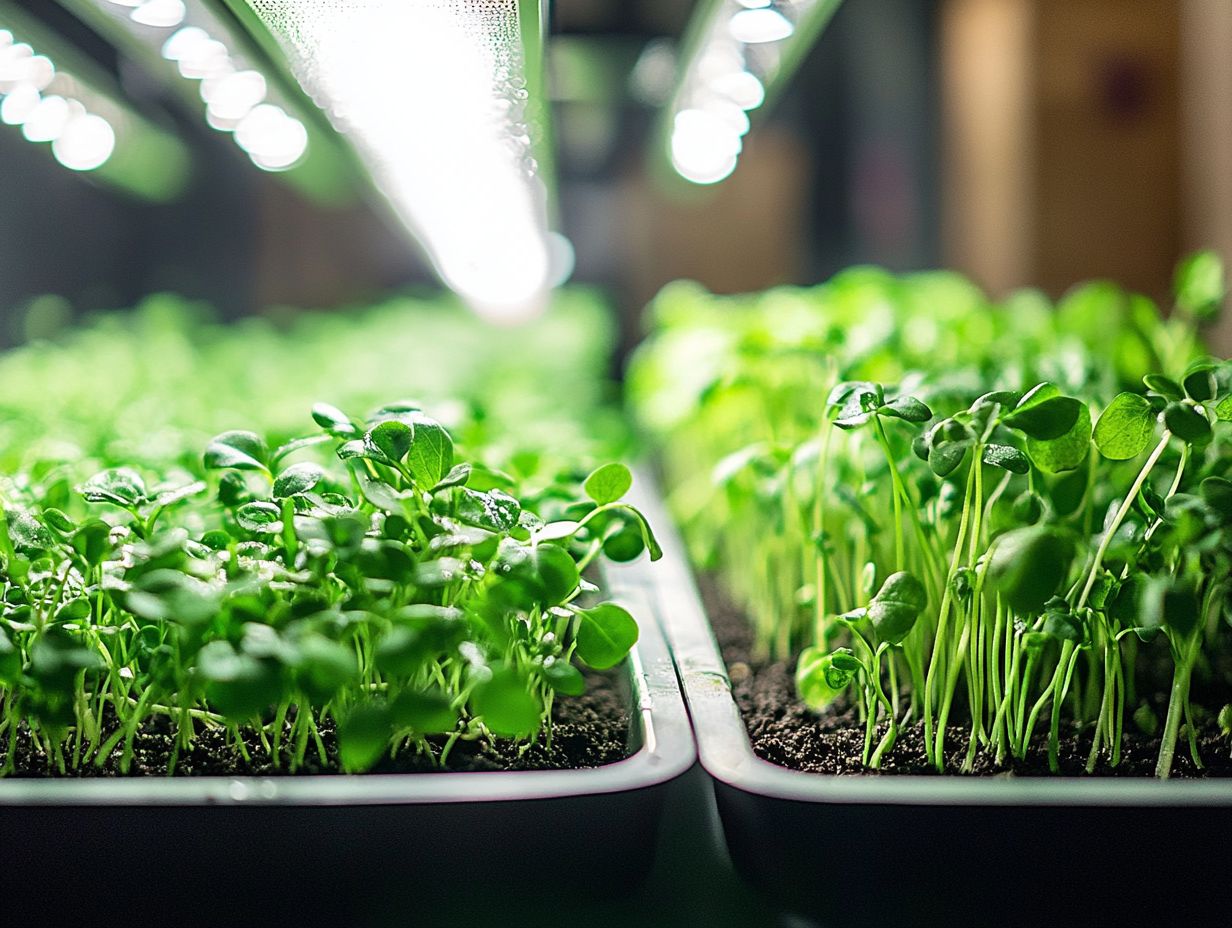
Light exposure profoundly influences the nutrient content and flavor profiles of microgreens. It shapes their antioxidant levels and overall appeal.
When microgreens bask in optimal light, their leaves burst with vibrant colors. They develop a more complex taste, as the intensity and spectrum of light boost the production of natural compounds that provide health benefits. Understanding the microgreen growth phases can further enhance your growing techniques.
Research shows that specific lighting conditions like full-spectrum or LED lighting can greatly enhance levels of beneficial compounds such as vitamin C, flavonoids, and carotenoids. These elements not only improve the health benefits of microgreens but also expand their cooking options.
Adjusting light duration and intensity creates remarkable flavor variations. Chefs and health enthusiasts should dive into these exciting growing techniques!
Frequently Asked Questions
What is the role of light in microgreen growth and harvest?
Light is the main energy source for photosynthesis, essential for microgreens’ growth and development.
How does light affect the growth of microgreens?
Light intensity, duration, and quality all influence microgreens’ growth. Adequate light exposure leads to strong, healthy plants.
What are the best light conditions for microgreen growth?
Microgreens thrive with both natural and artificial light. Natural light from a south-facing window is ideal, while artificial light supplements when needed.
Can microgreens be grown in low light conditions?
Yes, but growth may be slower, and colors may be lighter. It’s essential to provide some natural or artificial light for proper development.
How does light affect the flavor of microgreens?
Light duration and intensity impact flavor. Insufficient light can lead to bland or bitter-tasting microgreens, while proper exposure enhances their taste.
Is it necessary to adjust the light exposure for different types of microgreens?
Yes, each type of microgreen has its own light requirements. Research the specific needs of the type you’re growing for the best results.

